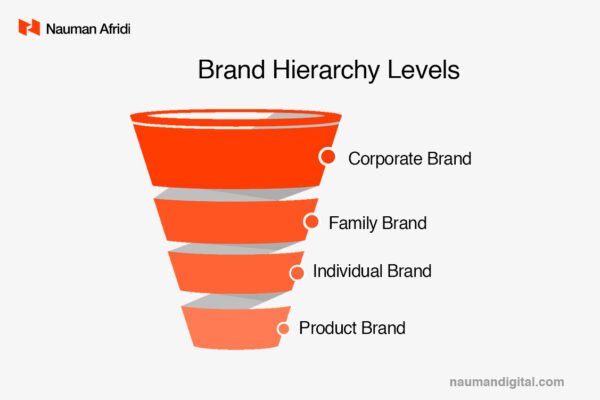Feeling uncertain about the concept of “branding”? No need to worry! Branding is a multifaceted marketing concept that can often be confusing, even for those well-versed in marketing principles. Today, we will explore “what is branding” by breaking it down into simple terms and examples.
To truly grasp the essence of branding, it’s essential to first understand the fundamental concepts of branding.
What is Branding?
Branding is the intricate process of shaping a robust, positive perception of a company, its products, or its services in the minds of consumers. This involves integrating elements such as logos, designs, and mission statements, and maintaining a consistent theme across all marketing communications. Effective branding is instrumental in helping businesses distinguish themselves from competitors and cultivate a devoted customer base.
Consistency is key in branding. Customers expect a uniform tone of voice across various platforms such as email, websites, customer service, and all other touchpoints within a business. If a rebranding effort is underway, alterations should be made to logos and styles both online and offline. Establishing a consistent brand presence across multiple channels ensures that customers engage seamlessly.
Branding operates on the premise that a brand must be meticulously planned, structured, managed, and promoted. These processes, constituting brand management, are integral components of successful branding efforts.
The objectives of branding encompass several crucial aspects:
- Ensuring that all stakeholders comprehend the company’s positioning.
- Elevating relevance in the market.
- Enhancing visibility.
- Cultivating a positive reputation among the public.
These strategic initiatives are pivotal for sustainable growth. Effective branding ensures intelligent and enduring business expansion. The focal point of brand management should revolve around defining the brand’s essence and how it aims to be perceived. Let’s delve deeper into this intricate topic.
What is a Brand?
A brand transcends mere visuals like logos or names; it encapsulates a spectrum of emotions and experiences that the audience associates with a product or service. This process is highly individualistic, as each person interprets a brand uniquely. Individual perspectives are heavily influenced by social, cultural, and economic contexts—essentially, the sum of one’s experiences with a company.
This inherent subjectivity underscores the necessity of a well-thought-out branding strategy. It’s important to acknowledge that a company cannot exercise complete control over how individuals perceive it. Consequently, differentiation from competitors becomes imperative.
Creating a distinctive brand involves delivering exceptional experiences from the initial interaction to the final engagement. A brand represents much more than a tagline or a slogan. For instance, Nike’s iconic “Just Do It” slogan embodies a customer-centric approach—management that prioritizes the needs and actions of the customer.
Brands require values and a purpose that serve as guiding principles for all their endeavors. These principles influence every stage, from product conception to advertising across various communication channels. When executed effectively, consumers can sense these values, leading a company to establish itself as a global leader, just like Nike has achieved worldwide recognition.
Building a Strong Brand: A Comprehensive Guide
Creating a brand or undergoing a rebranding process involves essential steps that are critical for your business’s success. Grab a notebook and be prepared to iterate through these processes, as building a powerful brand demands careful consideration.
Understand Your Audience
To establish a strong brand, you must first identify your target audience. Understanding your customers and their needs is vital for creating brand awareness, recognition, trust, and revenue. Personalization is key, with 70% of consumers seeking tailored experiences. Thorough research into your target market and buyer personas is essential. This initial step shapes all your subsequent branding decisions.
Craft Your Mission
Next, craft your mission statement by revisiting the fundamental question: Why did you start your business? Your answer forms the foundation of your mission statement, encapsulating your organization’s purpose and passion. This statement serves as the guiding light, defining your brand’s essence. It provides the framework for your logo, tagline, imagery, voice, and personality, ensuring consistency and resonance with your audience.
Remember, your brand is a holistic entity, reflecting not only what you offer but also why you matter. By deeply understanding your audience and articulating your mission, you pave the way for a brand that truly resonates, capturing attention, trust, and loyalty.
Defining Your Distinct Brand Essence
In a market flooded with businesses, it’s easy to get caught up in analyzing your competition. However, the spotlight should be on you right now. What truly sets your business apart from the rest? Your brand. Your brand is the one thing that distinguishes you legally and uniquely. It’s not just about your product features; it’s about the values, qualities, and benefits your company offers, enhancing lives and fostering success.
Take a moment to reflect on what makes your business special. Consider the positive impact your products or services have on people’s lives. A prime example is Tower 28 Beauty, a skincare brand that gained fame on TikTok. Their success isn’t solely due to their product features. It’s because they’ve transparently communicated their commitment to avoiding harmful ingredients, fostering trust and respect among their customers.
Creating a Visual Identity: Bringing Your Brand to Life
Once you’ve clarified your target audience, established your mission statement, and identified your unique qualities, it’s time to delve into the visually captivating realm of branding. This phase involves crafting your logo, selecting a color palette, choosing typography, creating icons, and other visual components that represent your brand essence.
To maintain consistency across all platforms, it’s crucial to develop a comprehensive set of brand guidelines or a brand style guide. These guidelines govern the composition and usage of your visual assets, ensuring a cohesive and recognizable brand identity.
While the design process can be both thrilling and daunting, consider seeking assistance from a professional designer experienced in logo and identity design. Alternatively, you can start with user-friendly design templates to kickstart your visual branding journey. Remember, your visual assets are not just about aesthetics; they’re about communicating your brand’s story effectively and leaving a lasting impression on your audience.
Crafting Your Brand’s Unique Voice
Consider your brand as if it were a person you’re having a conversation with or receiving a text from. Defining your brand’s voice is a crucial aspect of your branding strategy. It’s not just about what you say; it’s about how you say it. Your communication style with your target market is a significant part of your brand identity. Establishing a brand voice that resonates and connects with your audience is paramount; otherwise, your message might fall on deaf ears.
To create an effective brand voice, it’s essential to understand your audience thoroughly. Return to the foundational step of identifying your target market to ensure your tone aligns with their preferences and expectations. Consistency is key across all your communication channels, from advertising campaigns and social media posts to blog content and brand narratives. Your audience should become familiar with your brand’s voice, and ideally, it should be engaging and enjoyable. By infusing a touch of fun and entertainment into your voice, you can make your brand memorable, and customers will eagerly anticipate your social media updates and email communications.
Implement Your Branding Effectively
Your brand’s effectiveness is directly proportional to the effort you put into it. Once you’ve meticulously designed and conceptualized your new brand identity or rebranded your business, it’s imperative to integrate it comprehensively throughout your organization. Every interaction point with your customers should reflect your brand essence. Whether it’s your website, social media profiles, marketing materials, or customer service, your brand should be prominently displayed and consistently communicated. Pay meticulous attention to these details, ensuring your brand becomes an integral part of your customer experience, leaving a lasting impression at every touchpoint.
Strategically Branding Your Business Across Channels
Establishing a cohesive brand identity across various channels is pivotal for business success. Here’s how you can effectively brand your business across different platforms:
Website
Your website serves as a cornerstone of your brand identity. Ensure your logo, color scheme, and typography align with your brand guidelines. Consistency is key; any deviation can lead to a disjointed customer experience. Tailor your web copy, calls-to-action, and product descriptions to echo your brand voice. Utilize tools like website graders for valuable insights on enhancing your online presence.
Social Media
On social media, aim to heighten brand awareness. Use profile photos, cover art, and other visuals that mirror your brand identity. Consider featuring your logo prominently for instant recognition. All content, including posts and captions, should align with your brand voice, fostering a consistent online persona.
Packaging
For businesses with physical products, packaging becomes a tangible interaction point with customers. Design your packaging in alignment with your new branding, incorporating consistent colors, logos, and sizes. An exemplary case is Chobani, whose recyclable paper cups mirror their commitment to authenticity and health, creating a memorable brand experience for consumers.
Advertising
Advertisements, whether digital or print, play a vital role in brand awareness. A staggering 33% of marketers leverage paid ads for this purpose. It’s imperative that your branding seamlessly integrates into your ad campaigns. Utilize your brand style guide to simplify the ad creation process, ensuring uniformity in appearance and messaging.
Sales and Customer Service
Your brand’s strength lies in the people representing it. Educate your sales and customer service teams about your brand guidelines, emphasizing their use in customer interactions. Whether conducting product demos or addressing inquiries, encourage the consistent use of your logo, tagline, imagery, and brand voice. By aligning internal efforts with your brand identity, you empower your employees to effectively communicate your brand values, fostering customer trust and loyalty.
Remember, a well-executed brand strategy resonates across all touchpoints, creating a unified and compelling brand experience for your audience.
Essential Branding Concepts You Need to Grasp
To establish a compelling brand, it’s crucial to familiarize yourself with key branding concepts. Let’s delve into these terms, providing a deeper understanding of each:
Brand Identity
Think of well-crafted brands as distinct individuals, each with a personality, values, and experiences. Your brand identity encapsulates this unique persona, embodying the essence you want customers to associate with your company. It goes beyond a mere logo, representing the emotions and perceptions your brand evokes.
Brand Recognition
Brand recognition is the remarkable ability of consumers to associate specific brand assets with a particular company. For instance, the sight of a bitten apple instantly triggers thoughts of “Apple” or the tagline “There are some things money can’t buy” immediately brings “MasterCard” to mind. The magic lies in instant identification, without needing to see the company name, showcasing the effectiveness of well-established brand recognition.
Brand Awareness
Before a consumer considers purchasing from your brand, they must be fully aware of its existence. Cultivating brand awareness involves introducing your products, services, and brand identity to your target audience. When brand awareness reaches a significant level, your brand can become an “it” brand, chosen by many due to its popularity and trendiness.
Brand Management
Branding isn’t a one-time endeavor but an ongoing process requiring consistent management and maintenance. Brands need regular updates to remain contemporary and relevant. This encompasses refreshing packaging, visual elements, taglines, and other brand components. Continuous brand management ensures your brand stays fresh and resonates with evolving consumer preferences.
Brand Trust
Brand trust signifies the loyalty and confidence customers have in your brand. It reflects their belief in your brand’s ability to deliver reliable, high-value experiences. Customers trust brands that uphold promises, treat them with respect, and make them proud to associate with the brand. In an era where only a quarter of consumers trust larger businesses to fulfill their promises, building and maintaining high brand trust is a fundamental goal for every company.
By grasping these essential branding concepts, you lay the foundation for creating a powerful and enduring brand presence in the market.
Conclusion: The Vital Role of a Robust Branding Strategy
In the competitive landscape of today’s market, establishing and maintaining a strong branding strategy is not just important; it’s essential, particularly for companies aspiring to be market leaders. This process, however, is far from simple.
Consider the giants in various industries—Nike, Coca-Cola, Netflix. They didn’t just offer remarkable products; they crafted unique proposals, provided exceptional experiences, and mastered the art of communication. These factors, combined, elevated them from ordinary businesses to unbeatable market leaders.
The distinction between a shoe store and Nike, a beverage brand and Coca-Cola, or streaming platforms and Netflix lies in the power of their brands. Their brands drive customer loyalty, compelling consumers to choose them over competitors consistently.
Armed with the knowledge acquired, you now possess the tools to elevate your branding efforts. By implementing effective branding management strategies and creating a Content Style Guide, you can ensure that every aspect of your business aligns with your brand guidelines. This alignment not only transforms your brand but also strengthens your position in the market, captivating customers and fostering lasting relationships.
Ready to revolutionize your brand? Start applying these branding concepts and watch your business flourish. Don’t miss the chance; take our assessment now and embark on the journey to brand excellence!






![Brand Heritage Strategy [How To Evoke Emotion And Earn Trust]](https://naumandigital.com/wp-content/uploads/2023/02/11-600x400.jpg)
![What Is A Broad Differentiation Strategy? [The Definitive Guide]](https://naumandigital.com/wp-content/uploads/2023/10/WhatsApp-Image-2023-10-24-at-3.01.30-PM-600x400.jpeg)

